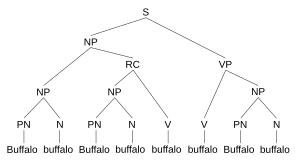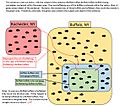Buffalo buffalo Buffalo buffalo buffalo buffalo Buffalo buffalo facts for kids

PN = Proper noun
N = noun
V = verb
NP = Noun phrase
RC = relative clause
VP = verb phrase
S = sentence
The sentence "Buffalo buffalo Buffalo buffalo buffalo buffalo Buffalo buffalo" is a real English sentence. It follows all the rules of grammar. People often use it to show how tricky words can be. It uses words that sound or are spelled the same but have different meanings. These are called homonyms and homophones.
This interesting sentence has been discussed for a long time. It first appeared in 1967 in a book called Beyond Language by Dmitri Borgmann. Later, in 1972, a professor named William J. Rapaport from the University at Buffalo in Buffalo, New York also used it.
The sentence does not use any punctuation. It uses the word "buffalo" in three different ways:
- The city: Buffalo (with a capital B) refers to the city of Buffalo in New York. It acts like an adjective here, describing where something is from.
- The animal: buffalo (lowercase b) means the animal, a bison. In this sentence, it's used in its plural form, meaning many buffalo.
- The action: buffalo (lowercase b) is a verb. It means to confuse or to scare someone.
You can think of the sentence like this: "Buffaloa buffalon Buffaloa buffalon buffalov buffalov Buffaloa buffalon". Here, 'a' stands for adjective, 'n' for noun, and 'v' for verb.
It means: "Bison from Buffalo, which other bison from Buffalo confuse, confuse the bison from Buffalo."
Let's break it down:
- The first two words, "Buffalo buffalo," mean "bison from Buffalo." It's like saying "Florida man" means a man from Florida.
- The next three words, "Buffalo buffalo buffalo," mean "which other bison from Buffalo confuse." The word which is left out, just like in "a man the woman loved" instead of "a man which the woman loved."
- The last three words, "buffalo Buffalo buffalo," mean "confuse the bison from Buffalo."
Other words can also make sentences like this. Examples include police, fish, and people. For example, "Fish fish fish fish fish" is another grammatically correct sentence. Sometimes, similar words spelled differently are used, like "Foul fowl foul fowl foul foul foul fowl."
Why the Sentence is Confusing
This sentence is very hard to understand at first because of several reasons:
- Most people do not use the word "buffalo" as a verb, meaning "to confuse" or "to scare."
- The plural form of the animal "buffalo" can be "buffalo" or "buffaloes." In this sentence, the form "buffalo" is used, which looks exactly like the verb.
- The sentence has no punctuation at all. This makes it harder to see where one idea ends and another begins.
- There are no words like that or which to help connect the different parts of the sentence. This makes it harder to follow the flow.
- The only way to tell the words apart is by their capitalization. A capital B is used only when "Buffalo" refers to the city. A lowercase b is used for both the animal (noun) and the action (verb).
- Hearing the same word repeated many times makes it confusing to read. Most words in English cannot be used in so many different ways in one sentence.
Images for kids
See also
 In Spanish: Buffalo buffalo Buffalo buffalo buffalo buffalo Buffalo buffalo para niños
In Spanish: Buffalo buffalo Buffalo buffalo buffalo buffalo Buffalo buffalo para niños


